Silent Garden Restaurant
No comments yet
SAR17

Open Now|11:00-22:00
+84 90 551 66 00
What travelers say:

This article is [Central Vietnam Diet Special] Before coming, the biggest expectations for Vietnam were Vietnamese powder, coffee, and rolls (non-fried vegetable rolls), especially Vietnamese powder. There was a house next to the office before, and I went to Shanghai every noon. But I have to say that the most surprising thing is the Vietnamese sandwich bánh m and fried roll CHẢ GI. Vietnamese sandwiches are conceptually like all sandwiches, two slices of bread filling, mainly characterized by the composition of these two materials. At first glance, the bread looks not good, very chewy, the bread skin is crisp, the air inside is enough, guessing that the local temperature is relatively high, so the fermentation degree is more sufficient. This bread is all over the street, one or two yuan can be bought, it is said to have been brought in by the French colonial period, so the local saying will also call him baguette. The fillings in the sandwiches typically contain sour cucumber, lettuce, peppers, beef or pork, and occasionally eggs and cheese, as well as parsley and some sausage. After the small talk inside, it was very good to be sandwiched in the crisp baguette, it was really happy [Wow] I tasted four different bahn mi in total, from the 70-year-old grandmother's street corner to the well-known local snacks to the hotel restaurant, not once disappointed! Vietnam rolls (Figure 8) are conceptually similar to our spring rolls, the name cha gio is the translation of the spring rolls, which can be collectively referred to as spring rolls of all Asian categories in English. Inside is generally meat filling, but it is the layer of the package that makes it better, instead of the general noodles, it is actually rice paper prepared with rice noodles. When fried, it will become a little bit, crispy taste is more obvious! Coffee can be said to be the most disappointing... I can't drink any beans taste, let alone say, other local flavors whether it is salt coffee salt coffee, egg coffee egg coffee (Figure 3) or general milk coffee are very simmering, somewhat difficult to appreciate. [Figure 16] In addition, the decoration of the restaurant is particularly in place, and the atmosphere is full. Whether it is a small street store or a relatively high-priced restaurant, it can always make people feel the feeling of being full of souls [eat melon] In contrast, a certain food desert is... Overall, in my limited observation, Vietnam's diet is relatively heavy with carbohydrate, but the vegetables are very fresh, and the eggs and dairy products are relatively small. It can be seen that it is a localized dietary treatment and vegetarianism are very friendly. No wonder it is so popular with European and American culture [eat melon] Figure 1 Silent Garden Figure 2 Unknown roadside shop Figure 3 Unknown roadside shop Figure 4 Desserts from a set The Sail Figure 5 bahn mi phuong Super delicious sandwich Figure 6 @ Banana Split Cafe Coffee brought to the local museum
More
Reviews of Silent Garden Restaurant
Some reviews may have been translated by Google Translate
0/5
All (1)
Latest
Photo reviews (1)
This article is [Central Vietnam Diet Special] Before coming, the biggest expectations for Vietnam were Vietnamese powder, coffee, and rolls (non-fried vegetable rolls), especially Vietnamese powder. There was a house next to the office before, and I went to Shanghai every noon. But I have to say that the most surprising thing is the Vietnamese sandwich bánh m and fried roll CHẢ GI. Vietnamese sandwiches are conceptually like all sandwiches, two slices of bread filling, mainly characterized by the composition of these two materials. At first glance, the bread looks not good, very chewy, the bread skin is crisp, the air inside is enough, guessing that the local temperature is relatively high, so the fermentation degree is more sufficient. This bread is all over the street, one or two yuan can be bought, it is said to have been brought in by the French colonial period, so the local saying will also call him baguette. The fillings in the sandwiches typically contain sour cucumber, lettuce, peppers, beef or pork, and occasionally eggs and cheese, as well as parsley and some sausage. After the small talk inside, it was very good to be sandwiched in the crisp baguette, it was really happy [Wow] I tasted four different bahn mi in total, from the 70-year-old grandmother's street corner to the well-known local snacks to the hotel restaurant, not once disappointed! Vietnam rolls (Figure 8) are conceptually similar to our spring rolls, the name cha gio is the translation of the spring rolls, which can be collectively referred to as spring rolls of all Asian categories in English. Inside is generally meat filling, but it is the layer of the package that makes it better, instead of the general noodles, it is actually rice paper prepared with rice noodles. When fried, it will become a little bit, crispy taste is more obvious! Coffee can be said to be the most disappointing... I can't drink any beans taste, let alone say, other local flavors whether it is salt coffee salt coffee, egg coffee egg coffee (Figure 3) or general milk coffee are very simmering, somewhat difficult to appreciate. [Figure 16] In addition, the decoration of the restaurant is particularly in place, and the atmosphere is full. Whether it is a small street store or a relatively high-priced restaurant, it can always make people feel the feeling of being full of souls [eat melon] In contrast, a certain food desert is... Overall, in my limited observation, Vietnam's diet is relatively heavy with carbohydrate, but the vegetables are very fresh, and the eggs and dairy products are relatively small. It can be seen that it is a localized dietary treatment and vegetarianism are very friendly. No wonder it is so popular with European and American culture [eat melon] Figure 1 Silent Garden Figure 2 Unknown roadside shop Figure 3 Unknown roadside shop Figure 4 Desserts from a set The Sail Figure 5 bahn mi phuong Super delicious sandwich Figure 6 @ Banana Split Cafe Coffee brought to the local museum